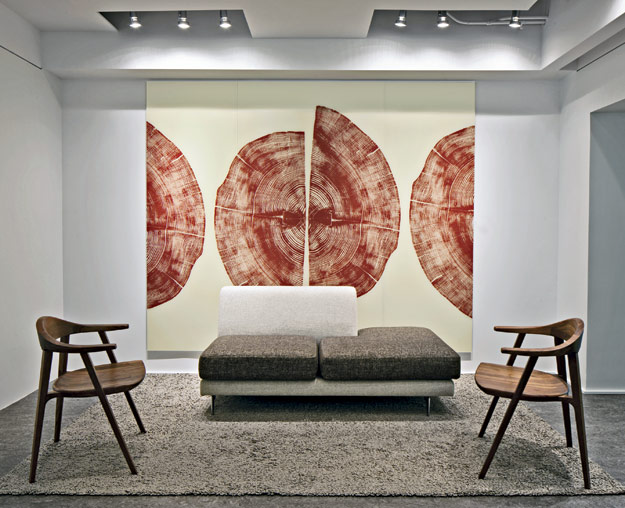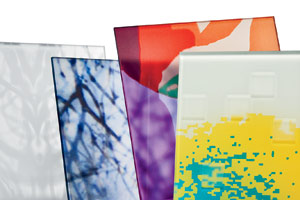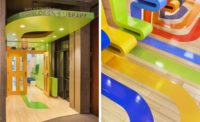 |
| Photo courtesy Skyline Design |
| Shown in full is Bryan Nash Gill's Double Crescent in red, with opaque Vitracolor backing. |

Photo courtesy Skyline Design
Close up, the designs in Skyline's Digital Glass Portfolio appear as abstract forms and pixels, some with vibrant color fields. Pictured (from left) are Navajo, Neil's Branches, Bloomshade, and Xylophone Variations.
It wasn't too long ago that the public marveled at the sight of custom-printed mugs and T-shirts. There's no way they could have imagined how printing would impact manufacturing, products, and, ultimately, architecture today. Since introducing its AST Digital Glass Printing technology for architectural glass six years ago, Skyline Design has been transforming rooms and buildings such as ZGF Architects' Randall Children's Hospital in Portland, Oregon, and the Martin Luther King Jr. Federal Building in Atlanta, to name two. The company's newest collection to utilize this technique, the Digital Glass Portfolio, features works by eight celebrated artists, reproduced large-scale (up to 72” x 144”) on low-iron PPG Starphire tempered glass with translucent or opaque backing. The resulting panels can serve as interior walls, demountable partitions, doors, and, of course, artwork.
The technological advances in printing have expanded the horizon for both products and artists. “The issue of scale is quickly dissolving,” says graphic designer Rick Valicenti, one of the eight tapped for the collection. Valicenti—who is a 2011 Cooper-Hewitt, National Design Award winner—and his studio, Thirst, easily transitioned from designing publishing and branding visuals to the larger products. Thirst's Alphablox is a playful homage to typography, and Line Dot is a pattern that lies somewhere between pointillism and pop art. Pixels and larger forms that come into focus when viewed from afar also figure in Sonnenzimmer's design Xylophone Variations, while Anne Lindberg's Pulse features colorful striations that evoke dangling strings.
Other designs draw on the beauty found in nature, such as the late Bryan Nash Gill's Double Crescent, based on his well-known Woodcuts series, which illustrates cross-sections of trees. And fine art photographer Doug Fogelson creates an ethereal and haunting composition of bare tree branches.
“The larger-than-life scale rewards us with a macro-level visual impact and a micro-intricacy up close,” says Valicenti. “It is complexity disguised as simplicity.” skydesign.com circle 200






Post a comment to this article
Report Abusive Comment